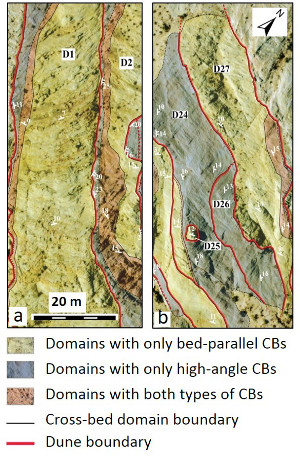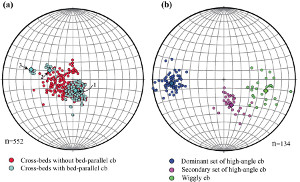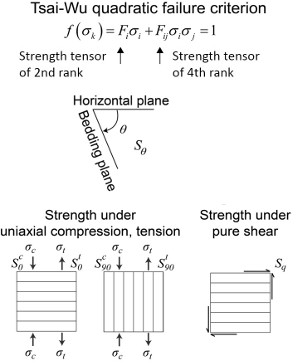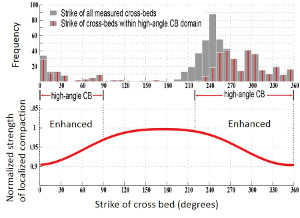| |||||||
|
|
|||||||
|
|
|||||||
| Mechanisms and Mechanics of Compaction Band Domains | |||||||
|
Isolation and enlargements of parts of the map in Figure 2 in the section entitled 'Compaction Band Domains' showing distribution of dunes numbered as D1, D2, etc. and color-coded compaction band domains from parts of the map are presented in Figure 1(a) and Figure 1(b). These maps show clearly that there exist multiple compaction band domains in a single dune (a) and sometimes an entire dune contains only one single compaction band domain (b). Deng and Aydin (2012) proposed that the orientation of the cross-beds and its variation control the presence and orientation of compaction bands and their patterns. Figure 2 shows the plot of cross-bed orientations with and without bed-parallel compaction bands (a) and with or without compaction bands at high-angle to cross-beds (b). Deng and Aydin (2015) in a follow-up paper used a quadratic failure criterion (given in compact form on the top of Figure 3) which was developed by Tsai and Wu (1971) for transversely isotropic materials to investigate the potential relationship between strength of localized compaction in layered material (Figure 3). Figure 4 shows strength of localized compaction (normalized by that of uniaxial compression normal to the bedding) for cross-bed orientations Bp1 250°/13°, Bp2 026°/13°, and Bp3 008°/36°. These values are chosen based on the field data on the presence of bed-parallel compaction bands along the cross-beds in these orientations. Figure 4(a) shows strike of cross-beds with two ranges corresponding to the main categories (Bp1, Bp2, and Bp3) and Figure 4(b) shows the strength of localized compaction for different cross-bed dip values, again based on the field observations. For the lower dip-angle group (10° and 20°), the strike of cross-bed range falls between 210° and 270°. In contrast, for the higher dip-angle group (30° and 36°), it is between 0° and 30° and 330° and 360°. The field observations match the model results quite well. Figures 5(a) and (b) show the plot of the observed field data (a) and the calculated model results (b) for high-angle to bedding compaction bands and normalized strength of localized compaction with respect to the attitude of the cross-beds with and without the high-angle compaction bands. The enhanced ranges (double arrows) indicated by relatively lower strength values match well with the observed distribution of high-angle compaction bands in high frequency. | |||||||
| Reference: |
|||||||
| Deng, S., Aydin, A., 2012 Deng, S., Aydin, A., 2015 |
|||||||
|
Readme | About Us | Acknowledgement | How to Cite | Terms of Use | Ⓒ Rock Fracture Knowledgebase |
|||||||




